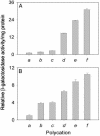Conjugation to gold nanoparticles enhances polyethylenimine's transfer of plasmid DNA into mammalian cells
- PMID: 12886020
- PMCID: PMC170885
- DOI: 10.1073/pnas.1233634100
Conjugation to gold nanoparticles enhances polyethylenimine's transfer of plasmid DNA into mammalian cells
Abstract
Branched polyethylenimine (PEI) chains with an average molecular mass of 2 kDa (PEI2) have been covalently attached to gold nanoparticles (GNPs), and the potency of the resulting PEI2-GNPs conjugates as vectors for the delivery of plasmid DNA into monkey kidney (COS-7) cells in the presence of serum in vitro has been systematically investigated. The transfection efficiencies vary as a function of the PEI/gold molar ratio in the conjugates, with the best one (PEI2-GNPII) being 12 times more potent than the unmodified polycation. This potency can be further doubled by adding amphiphilic N-dodecyl-PEI2 during complex formation with DNA. The resulting ternary complexes are at least 1 order of magnitude more efficient than the 25-kDa PEI, one of the premier polycationic gene-delivery vectors. Importantly, although unmodified PEI2 transfects just 4% of the cells, PEI2-GNPII transfects 25%, and the PEI2-GNPII/dodecyl-PEI2 ternary complex transfects 50% of the cells. The intracellular trafficking of the DNA complexes of these vectors, monitored by transmission electron microscopy, has detected the complexes in the nucleus <1 h after transfection.
Figures





References
Publication types
MeSH terms
Substances
Grants and funding
LinkOut - more resources
Full Text Sources
Other Literature Sources

